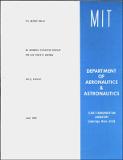| dc.contributor.author | Ezekiel, Solly | en_US |
| dc.contributor.other | Massachusetts Institute of Technology. Flight Transportation Laboratory | en_US |
| dc.date.accessioned | 2012-01-06T22:07:58Z | |
| dc.date.available | 2012-01-06T22:07:58Z | |
| dc.date.issued | 1985 | en_US |
| dc.identifier | 13355769 | en_US |
| dc.identifier.uri | http://hdl.handle.net/1721.1/68076 | |
| dc.description | June, 1985 | en_US |
| dc.description | Also issued as an M.S. thesis, Massachusetts Institute of Technology, Dept. of Aeronautics and Astronautics, 1985 | en_US |
| dc.description | Includes bibliographical references (leaf 63) | en_US |
| dc.description.abstract | A new approach to presenting Air Traffic Control (ATC) situation information to controllers has been devised and implemented. The approach allows the controller to spend more time analyzing traffic trends by decreasing the effort required to issue flight vectors; increases the amount of information available to the controller through the situation display; improves the presentation of altitude information; and interfaces the controller with an improved ground-to-air communication system. These objectives necessitated the use of a raster display device; the particular hardware used for the implementation was a Digital Equipment Corporation (DEC) VAXstation-100 display. Although the VAXstation- 100 machine was adequate for the task, the effort identified shortcomings of raster display technology that must be rectified before raster machines may be used for ATC applications. In particular, the window management system should handle non-rectangular bitmaps. The use of a positional entry device (PED) was found to be beneficial in accessing the functions of the advanced display, and in alleviating controller workload by reducing the amount of verbal controller-pilot communication. It was found that the functions specified above can be implemented on existing hardware, but that the functions require large computational resources to operate in real time. More data are needed before the benefits of the functions can be quantified. | en_US |
| dc.format.extent | 63 leaves | en_US |
| dc.publisher | Cambridge, Mass. : Massachusetts Institute of Technology, Flight Transportation Laboratory, [1985] | en_US |
| dc.relation.ispartofseries | FTL report (Massachusetts Institute of Technology. Flight Transportation Laboratory) ; R85-8 | en_US |
| dc.subject | Air traffic control | en_US |
| dc.title | An advanced situation display for air traffic control | en_US |
| dc.type | Technical Report | en_US |
